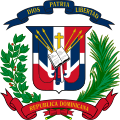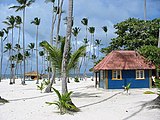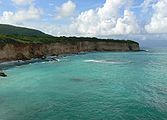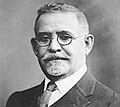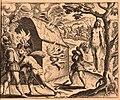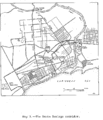Introduction
The Dominican Republic is a country on the island of Hispaniola in the Greater Antilles archipelago of the Caribbean Sea, bordered by the Atlantic Ocean to the north. Geographically, the Dominican Republic is part of the North American continent. It occupies the eastern five-eighths of the island, which it shares with Haiti, making Hispaniola one of only two Caribbean islands, along with Saint Martin, that is shared by two sovereign states. It is the second-largest nation in the Antilles by area (after Cuba) at 48,671 square kilometers (18,792 sq mi), and second-largest by population, with approximately 11.4 million people in 2024, of whom approximately 3.6 million live in the metropolitan area of Santo Domingo, the capital city. The Dominican Republic has the largest economy (according to the U.S. State Department and the World Bank) in the Caribbean region and is the seventh-largest economy in Latin America. Over the last 25 years, the Dominican Republic has had the fastest-growing economy in the Western Hemisphere – with an average real GDP growth rate of 5.3% between 1992 and 2018. GDP growth in 2014 and 2015 reached 7.3 and 7.0%, respectively, the highest in the Western Hemisphere. Recent growth has been driven by construction, manufacturing, tourism, and mining. The country is the site of the third largest (in terms of production) gold mine in the world, the Pueblo Viejo mine. The Dominican Republic is the most visited destination in the Caribbean. The year-round golf courses and resorts are major attractions. A geographically diverse nation, the Dominican Republic is home to both the Caribbean's tallest mountain peak, Pico Duarte, and the Caribbean's largest lake and lowest point, Lake Enriquillo. The island has an average temperature of 26 °C (78.8 °F) and great climatic and biological diversity. The country is also the site of the first cathedral, castle, monastery, and fortress built in the Americas, located in Santo Domingo's Colonial Zone, a World Heritage Site. (Full article...) Selected article - The recorded history of the Dominican Republic began in 1492 when the Genoa-born navigator Christopher Columbus, working for the Crown of Castile, happened upon a large island in the region of the western Atlantic Ocean that later came to be known as the Caribbean. It was inhabited by the Taíno, an Arawakan people, who called the eastern part of the island Quisqueya (Kiskeya), meaning "mother of all lands." Columbus promptly claimed the island for the Spanish Crown, naming it La Isla Española ("the Spanish Island"), later Latinized to Hispaniola. After 25 years of Spanish occupation, the Taíno population in the Spanish-dominated parts of the island drastically decreased through genocide. With fewer than 50,000 remaining, the survivors intermixed with Spaniards, Africans, and others, forming the present-day tripartite Dominican population. What would become the Dominican Republic was the Spanish Captaincy General of Santo Domingo until 1821, except for a time as a French colony from 1795 to 1809. It was then part of a unified Hispaniola with Haiti from 1822 until 1844. In 1844, Dominican independence was proclaimed and the republic, which was often known as Santo Domingo until the early 20th century, maintained its independence except for a short Spanish occupation from 1861 to 1865 and occupation by the United States from 1916 to 1924. During the 19th century, Dominicans were often at war, fighting the French, Haitians, Spanish, or amongst themselves, resulting in a society heavily influenced by caudillos, who ruled the country as if it were their personal kingdom. Between 1844 and 1914, the Dominican Republic experienced multiple transitions in leadership, with 53 presidents (only 3 completing their terms) and the adoption of 19 constitutions. Many leaders seized power through military force. Around 1930, the Dominican Republic found itself under the control of the dictator Rafael Trujillo, who ruled the country until his assassination in 1961. Juan Bosch was elected president in 1962 but was deposed in a military coup in 1963. In 1965, the United States led an intervention in the midst of a civil war sparked by an uprising to restore Bosch. In 1966, the caudillo Joaquín Balaguer defeated Bosch in the presidential election. Balaguer maintained a tight grip on power for most of the next 30 years when U.S. reaction to flawed elections forced him to curtail his term in 1996. Since then, regular competitive elections have been held in which opposition candidates have won the presidency. (Full article...)General images -The following are images from various Dominican Republic-related articles on Wikipedia.
Selected picture -A view of the coastline at Monte Cristi Province
Selected biography -Joaquín Antonio Balaguer Ricardo (1 September 1906 – 14 July 2002) was a Dominican politician, scholar, writer, and lawyer. He was President of the Dominican Republic serving three non-consecutive terms for that office from 1960 to 1962, 1966 to 1978, and 1986 to 1996. His enigmatic, secretive personality was inherited from the Trujillo era, as well as his desire to perpetuate himself in power through dubious elections and state terrorism, and he was considered to be a caudillo. His regime of terror claimed 11,000 victims who were either tortured or forcibly disappeared and killed. Nevertheless, Balaguer was also considered to be instrumental in the liberalization of the Dominican government, and his time as leader of the Dominican Republic saw major changes such as legalized political activities, surprise army promotions and demotions, promoting health and education improvements and instituting modest land reforms. (Full article...)Related portalsWikiProjects
Things to do
Associated WikimediaThe following Wikimedia Foundation sister projects provide more on this subject:
SourcesDiscover Wikipedia using portals | |||||||||||||||||||||||||
